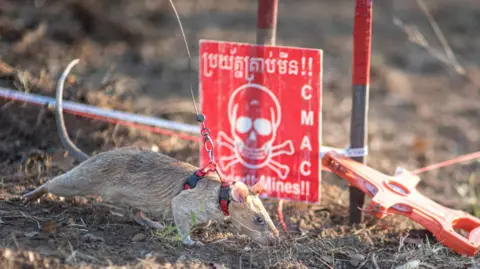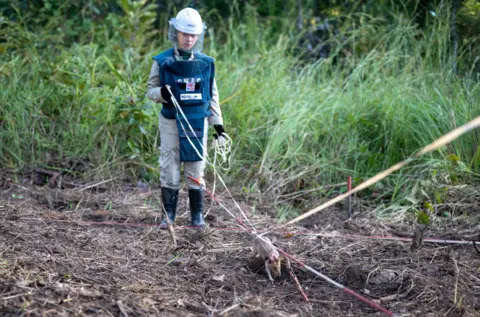Ronin the Rat: A Champion in Clearing Cambodia‘s Landmines
Table of Contents
- Ronin the Rat: A Champion in Clearing Cambodia’s Landmines
- The Future of Landmine detection: Innovations and Trends Shaping the Path Ahead
Published: [Current Date]

A Milestone in Mine Detection
In a remarkable achievement, Ronin, a landmine-detecting rat operating in Cambodia, has established a new benchmark by becoming the first rodent to identify over 100 landmines and other hazardous remnants of war. This feat underscores the critical role these animals play in humanitarian demining efforts.
According to a statement from Apopo, the organization responsible for training these remarkable creatures, Ronin, an African giant pouched rat, has successfully located 109 landmines and 15 pieces of unexploded ordnance as 2021. This contribution substantially enhances the safety and security of communities in affected regions.
The Lingering Threat of unexploded Ordnance in Cambodia
Cambodia continues to grapple with the pervasive issue of unexploded munitions, a result of nearly two decades of civil conflict that concluded in 1998. The presence of these hidden dangers poses a significant threat to the population, hindering advancement and causing tragic accidents.
The gravity of Ronin’s work is highlighted by the Guinness Book of World Records, which acknowledged that his crucial work
is making a tangible difference for individuals who have had to endure the fear that one misstep while going about their day-to-day lives could be their last.
Apopo’s Heroic Rodent Program
Apopo, headquartered in Tanzania, currently manages a cohort of 104 trained rodents, affectionately known as HeroRATS. These animals undergo specialized training to detect the chemical compounds present in landmines and other weapons left behind on former battlegrounds.Their small size ensures they are too light to trigger the detonation of these devices.
The efficiency of these HeroRATS is astounding. Apopo estimates that a rat can survey an area equivalent to a tennis court in approximately 30 minutes. In contrast, a human using a metal detector could require up to four days to cover the same ground. This speed and accuracy make them invaluable assets in demining operations.
Beyond landmine detection, these remarkable rats are also trained to identify tuberculosis. apopo asserts that they can detect tuberculosis far quicker than it would be found in a lab using conventional microscopy.

Ronin’s Predecessor and Apopo’s Global Impact
ronin’s exceptional performance in the Preah Vihear province of northern Cambodia surpasses the previous record held by Magawa, a rat who located 71 mines and received a gold medal in 2020 for his heroic efforts. Magawa’s story brought international attention to the vital work of these animals.
As its inception 25 years ago, Apopo has been instrumental in clearing 169,713 landmines and other explosives worldwide, with over 52,000 of these cleared in Cambodia alone. The organization extends its demining efforts to other war-affected nations, including Ukraine, South Sudan, and Azerbaijan, demonstrating its commitment to global safety and security.
Despite these efforts, the Landmine monitor estimates that there are still four to six million landmines and other unexploded munitions buried in Cambodia, highlighting the ongoing need for demining initiatives and the continued importance of HeroRATS like Ronin.
* What are the primary challenges in landmine detection and clearance?
The Future of Landmine detection: Innovations and Trends Shaping the Path Ahead
Published: April 4, 2025
Advancements in Animal-assisted Detection
The use of animals in landmine detection has proven effective, with organizations like APOPO training rats to locate explosives.These HeroRATS have demonstrated remarkable efficiency, covering areas the size of a tennis court in approximately 30 minutes. Their small size ensures they are too light to trigger detonations, making them invaluable in demining operations. ([ft.com](https://www.ft.com/content/fea05abc-c9bb-428e-aa0f-67fb54dd4d1f?utm_source=openai))
Expanding Roles in Conservation Efforts
Beyond landmine detection, these trained rats are now being utilized to combat illegal wildlife trade. In Tanzania, they have been trained to detect contraband such as rhinoceros horns and pangolin scales, showcasing their versatility and cost-effectiveness compared to conventional detection methods. ([ft.com](https://www.ft.com/content/fea05abc-c9bb-428e-aa0f-67fb54dd4d1f?utm_source=openai))
technological Innovations in Detection Methods
Advancements in technology are revolutionizing landmine detection,offering faster and more accurate methods.
Laser Vibration Sensing Technology
Researchers at the National Center for Physical Acoustics have developed a laser multibeam vibration sensor capable of detecting buried landmines more efficiently than traditional methods. This technology creates a vibration map of the ground in less than a second,enhancing detection speed and accuracy. ([phys.org](https://phys.org/news/2024-10-laser-vibration-technology-landmines-faster.html?utm_source=openai))
Magnetic Resonance Detection
CSIRO, Australia’s national science agency, has developed magnetic resonance technology that detects the molecular signature of explosives used in landmines. This method offers heightened accuracy, reducing false positives and improving safety for demining personnel. ([csiro.au](https://www.csiro.au/en/news/all/news/2023/april/csiro-technology-to-help-global-landmine-clearing-efforts?utm_source=openai))
Integrating Traditional and Modern Approaches
Combining animal-assisted detection with technological innovations is enhancing demining efforts. As an example, elephants, known for their exceptional sense of smell, have been trained to detect TNT, demonstrating a high sensitivity rate of 99.7%. while not suitable for direct fieldwork due to their size, their abilities can support demining operations through remote detection methods. ([weforum.org](https://www.weforum.org/agenda/2017/10/the-latest-technology-in-landmine-detection-an-elephant/?utm_source=openai))
collaborative Efforts for Global Impact
Organizations like APOPO are expanding their training programs to include various animals, enhancing the global capacity for landmine detection.Their work not only addresses the immediate threat of landmines but also contributes to broader conservation and humanitarian goals. ([ft.com](https://www.ft.com/content/fea05abc-c9bb-428e-aa0f-67fb54dd4d1f?utm_source=openai))
Looking Ahead: The Future of Landmine Detection
The future of landmine detection lies in the synergy between biological detection methods and technological innovations. Ongoing research and development are expected to yield more efficient,cost-effective,and safer demining techniques,ultimately leading to a world free from the threat of landmines.
Frequently asked Questions
- What are HeroRATS?
- HeroRATS are African giant pouched rats trained by organizations like APOPO to detect landmines and other explosives, as well as contraband in wildlife trafficking.
- How do laser vibration sensors detect landmines?
- Laser vibration sensors create a vibration map of the ground by emitting laser beams and analyzing the reflected light to identify anomalies indicative of buried objects like landmines.
- Can elephants be used in landmine detection?
- While elephants have an exceptional sense of smell and can detect TNT, their size makes them unsuitable for direct fieldwork.However, their abilities can support demining operations through remote detection methods.
Did You Know?
Elephants have the highest count of olfactory receptor genes among tested species, making them perhaps the best smellers in the animal kingdom. ([weforum.org](https://www.weforum.org/agenda/2017/10/the-latest-technology-in-landmine-detection-an-elephant/?utm_source=openai))
Pro Tips for Staying Informed
Stay updated on the latest advancements in landmine detection by following reputable organizations like APOPO and CSIRO, and subscribing to scientific journals and news outlets that cover humanitarian demining efforts.
Join the Conversation
What are your thoughts on the integration of animal-assisted detection and technological innovations in demining efforts? Share your insights in the comments below or explore more articles on this topic.
